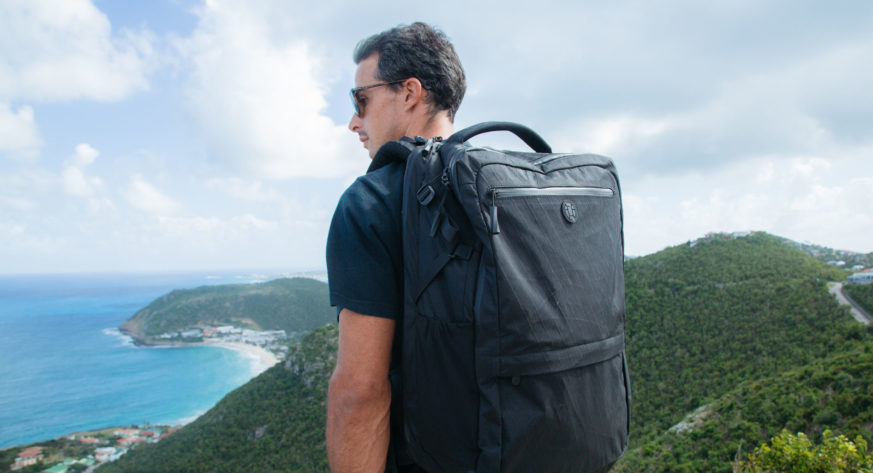Travel Backpack Buyer’s Guide: Based on 12 Years of Design Experience

The Tortuga Promise
At Tortuga, our mission is to make travel easier. Our advice and recommendations are based on years of travel experience. We only recommend products that we use on our own travels.
Table of Contents
In 2009, I went to the North Face store in downtown San Francisco to buy my first
I did weeks of bag research in stores and online. Like most backpackers, I bought a hiking bag, even though I was traveling through European cities by train, not hiking the Alps.
The trip was a blast, but my luggage was a disaster. I had to check my bag on my flights to Frankfurt. Once I arrived, I had to pack and repack my bag every day.
This
When you travel, you live out of your backpack. You can’t afford to have the wrong one.
Pack for trips of one week or more without checking a bag.
- Thick comfortable straps
- Easy to organize
- Durable, waterproof fabric
- Backed by our Worldwide Warranty
Why You Should Trust Us
I’ve been obsessing over, designing, making, selling, and—most importantly—carrying travel backpacks since 2010.
After that trip to Europe, my then travel partner and now business partner, Jeremy, and I created the first modern
When we started, we were frustrated travelers with strong opinions but zero knowledge of how to make a physical product.
Over the last twelve years, we’ve designed 13 different travel backpacks, made them at four factories in three countries, and worked with six industrial designers. Most importantly, we’ve sold thousands of backpacks and received hundreds of reviews.
Most
We’ve turned our opinions into real products and proven them in the marketplace for over a decade. We’ve had to earn travelers’ dollars, not just their clicks. Travelers have voted with their wallets and given us feedback through reviews, surveys, comments, and emails.
So, yes, we do sell travel backpacks. And we even hope you’ll buy one from us. But we also have years of product design experience and customer feedback to tell us where we’re wrong and what people really want. This guide will share what we’ve learned from travelers like you. We hope that it will help you find the right bag and to make your travels easier. Even if you don’t buy from us.
The Problems with Other Luggage
Let’s start with the problems, which you may have experienced, with most luggage. Then we’ll move on to how travel backpacks solve these problems.
The Problem with Hiking Backpacks
Most travelers make the same mistake that I did. They picture a backpacker carrying a tall, cylindrical bag: a hiking backpack. So that’s what they buy. Those bags are comfortable and work well for hiking, but they don’t work for travel.
Hiking backpacks are too large to be carried on to your flight so you’ll pay an extra $50 roundtrip to check your too-large bag. Plus, you run the risk of having your bag lost, misrouted, or damaged by the airline. Do you trust all those straps not to get caught and torn on something after being tossed around by the baggage handlers?
The second problem with hiking packs is that they load from the top, like a garbage bag. Any time you want to grab something that isn’t at the top of your bag, you have to dump everything out, grab what you need, and repack the whole bag.
Packing is the least fun part of traveling. You don’t want to have to pack and unpack multiple times every day. You need a better layout for organization and easy access.
The Problem with Suitcases
Suitcases work well for a certain type of travel. As long as you’re on the smooth, polished surface of an airport or hotel, you’re good. But suitcases aren’t made for city travel. Good luck dragging a suitcase over the cobblestone streets of Europe. Those delicate little plastic wheels weren’t made for city life.
The third-floor Airbnb you booked probably doesn’t have an elevator, so you’ll have to drag your suitcase up three flights of stairs. In many cases, suitcases weigh you down.
You need luggage that’s hands-free and that will let you breeze through the airport, navigate the city, and get to your destination.
You need a
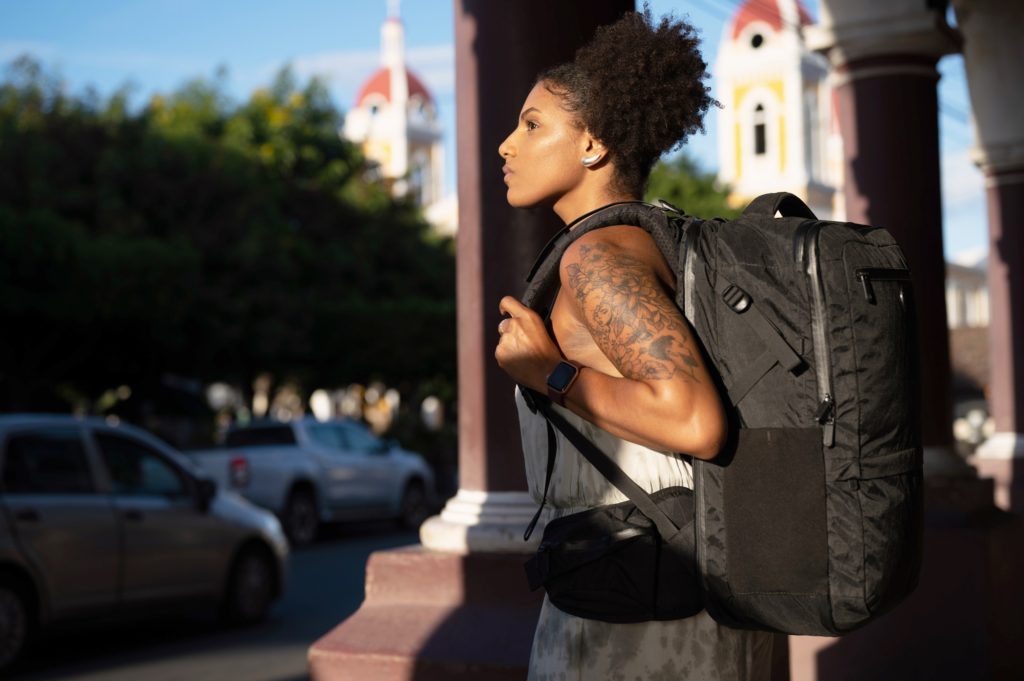
What to Look for in a Travel Backpack
When you’re shopping for a
- Carry-on-sized
- Easy to pack
- Comfortable to carry
- Durable for life on the road
These are the four pillars on which we’ve built every one of our travel backpacks.
Pack for trips of one week or more without checking a bag.
- Thick comfortable straps
- Easy to organize
- Durable, waterproof fabric
- Backed by our Worldwide Warranty
The Travel Backpack solves the problems with suitcases and hiking packs by combining the best features of both. In the
Carry-On-Sized
Your
That’s the most important thing to know before buying a bag. Why does this matter?
As we discussed above, when you travel carry-on-only, you won’t have to worry about your airline losing or damaging your bag. Without checked luggage, you’ll have less physical and mental burdens.
Less stuff means less to carry and less to worry about. You won’t have to stand around waiting for your gear at the baggage claim. You’ll breeze through the airport and get started on your trip. You’ll save time, money, and hassle.
If you’ve never packed this light before, start with the Step Down to Carry On series to learn how to go from checking bags to traveling light by scaling down your packing one step at a time.
When you
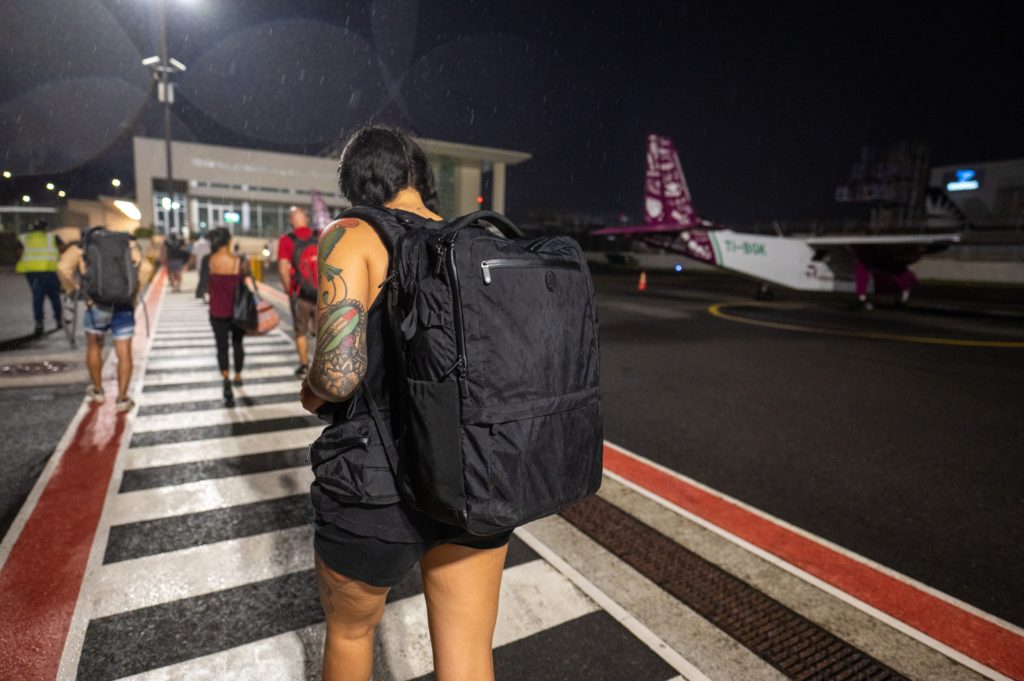
Volume
The exact right size for you depends on where you’re going, how long you’re staying, and how you pack.
For starters, backpack volume and airline size allowances are measured in liters. One liter is equal to 61 cubic inches. Neither measurement is intuitive. Just know that the maximum that most airlines allow is 45L.
Have you ever seen that “cage” next to the boarding gate where you can check to see if your luggage is the right size? That cage is 45L, though it can vary by airline.
Always check your airline’s rules before flying, especially when flying internationally or with a budget carrier as they tend to be stricter with size and weight allowances.
- 45L is the maximum allowed size on most US airlines. The dimensional measurements are typically 22 x 14 x 9 in or 45 linear linear inches (length + width + height). If you want to travel carry-on-only but maximize every inch possible, this is the size for you.
- 40L is the maximum size allowed on many international airlines. The measurements for this volume are 55 x 35 x 20 cm. Technically, the volume for those measurements is 38.5L, but the number is often rounded up for clarity. If you want to maximize your
carry on but still be compliant for flights in Europe, Asia, and around the world, this is a safer size. - 30-35L: Going below 40L for your bag is a personal choice, not one set by the airlines. However, a mid-sized bag can be the best option for shorter trips (under one week) and for light packers.
- <30L: Packing under 30L is impressive, even on short weekend trips. Below 30L starts to approach the size of a personal item that can be packed under the seat in front of you, rather than a
carry on that goes in the overhead bin. Some hardcore minimalists travel with bags under 20L, though most people won’t want to travel that light.
Shape
Now, you must consider tradeoffs. Airlines base their
One Bag has a great breakdown of rectilinearity in bags.
A rectangle may maximize packing volume, but most people don’t want a bag that’s all straight lines and right angles. The shape just isn’t attractive, especially at the size of a
A small Tumi or Fjallraven backpack can look good despite its rectangular shape. But most people don’t like the look of a large, boxy
Weight
When you check a bag, the ticketing agent will weigh it. Usually, they won’t weigh a
Don’t take any chances. Make sure to check your airline’s weight limit and weigh your bag before your trip. Carry on weight limits vary, but 22 lb (10 kg) is a common rule. Make sure that your bag doesn’t use up too much of your
Buy a digital luggage scale on Amazon for $10 and weigh your bag before you leave. The scale will pay for itself the first time you find that your bag is overweight. Buying the scale is cheaper than having to check a bag.
Don’t prioritize weight over
Now that you understand the ideal size for a
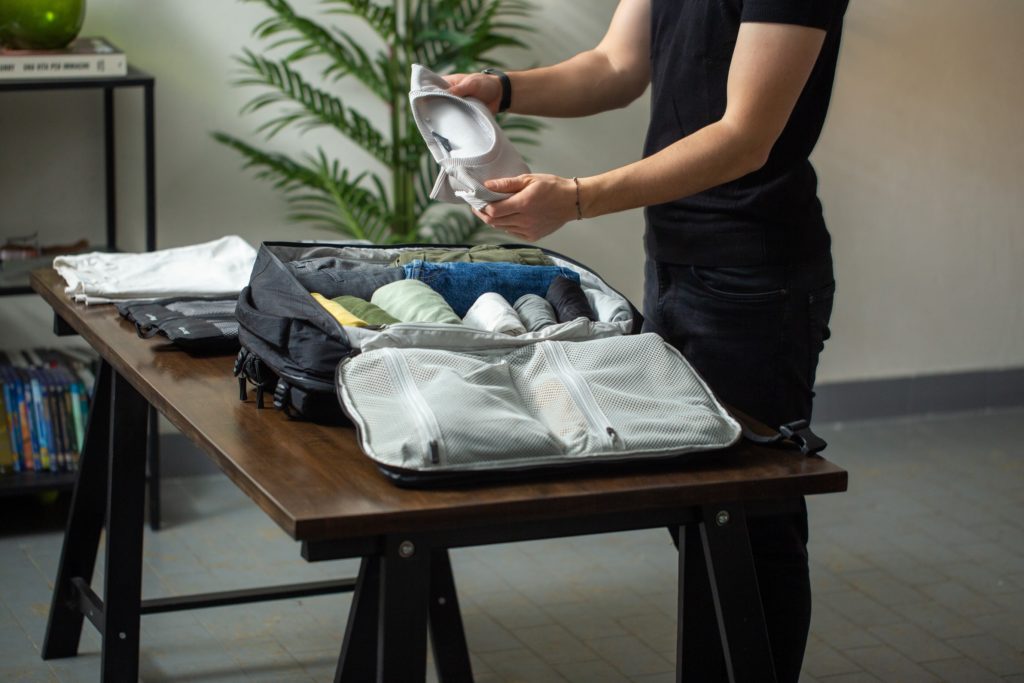
Easy to Pack
Front-Loading
At the start of this post, you read about the shortcomings of suitcases for city travel. But suitcases have one really important advantage.
Suitcases allow you to easily see, organize, and reach all of your stuff. This accessibility is the biggest advantage that suitcases have over hiking packs.
A
After size, the opening style is the second most important feature of travel backpacks.
A front-loading, also called panel-loading, bag is better than a top-loading bag because it allows for maximum accessibility and organization. Hiking packs are top-loading because access and organization is less important when hiking. When you’re traveling, you want to be able to grab one thing without digging through your whole bag to find it.
The wide opening and accessibility allows you to organize your bag however you like. You can separate your clothes by type or pack outfits together. You can pack by weight so that your bag is more comfortable to carry.
One final note here: your bag should open right to left like a book, not downward. Opening to the side is more natural and lets you place your bag on a bed or luggage stand for easier packing.
If your bag opens downward, it’s harder to lay out and pack. If you have anything packed in the front pocket, you’ll be turning it upside down and dumping it out while packing the main compartment with clothes. Many travel backpacks get this wrong, so make sure to check how a bag opens before buying it.
Compartments and Pockets
The second part of organization is more subjective. Some travelers like pockets for everything. Some prefer a more flexible, less “opinionated” bag that lets them pack as they like. The right answer is somewhere in the middle. A good
You will definitely want a separate, dedicated laptop pocket to protect your computer and make it easier to slide it in and out at security checkpoints. Your computer should be completely separated from your clothes.
At a minimum, you’ll also want a separate compartment or pocket for small stuff like money and pens so that they don’t get lost in the main compartment among your clothes. I like a few spots for cards, foreign money, a charger, a pen, and a notebook. Your needs may differ, but everyone has a few small objects they want to keep track of.
The main compartment, where you pack your clothes and maybe your toiletries, should either be one big compartment or two compartments divided somewhere between 50/50 and 25/75. A second section there can be handy for separating dirty clothes from clean clothes or socks and underwear from the rest of your clothes.
If you want maximum organization, don’t expect it from your
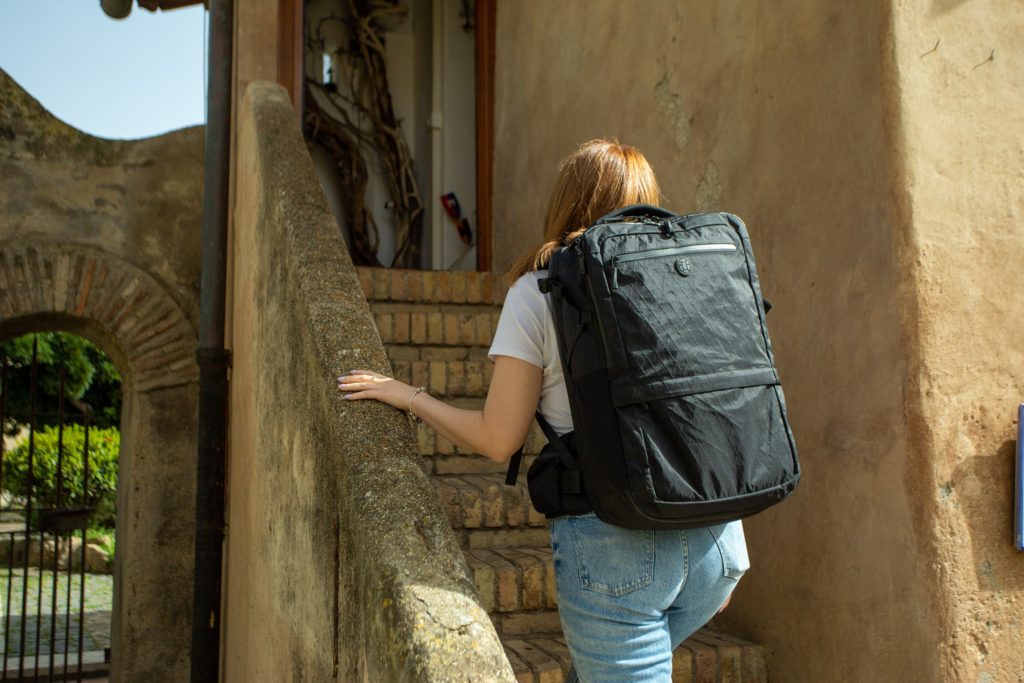
Comfortable to Carry
Even over short distances, your backpack must be comfortable to carry.
Maybe you’ll only carry it through the airport or when walking into your hotel. You might not think much about comfort until you need it. Then, one day, you have to carry your bag around all day. Or the best transportation option is to walk two miles.
In that situation, the wrong bag will wreck your neck and shoulders. You’ll feel every ounce that you packed and regret everything that you brought.
You won’t wear your bag around all day like you would a hiking pack, but your
A carry-on-sized bag is smaller than most hiking packs, so it can be made to be comfortable. But a poorly-designed maximum-sized
So how do you know if a bag is going to be comfortable? Most people would just look for thick, soft shoulder straps. The padding in the shoulder straps matters but is far from the most important feature. Below are the more important features to look for in a comfortable bag.
The “suspension system” of the bag is the shoulder straps, sternum strap, hip belt, and load lifters. Everything that attaches the bag to your body and dictates the comfort of your carry.
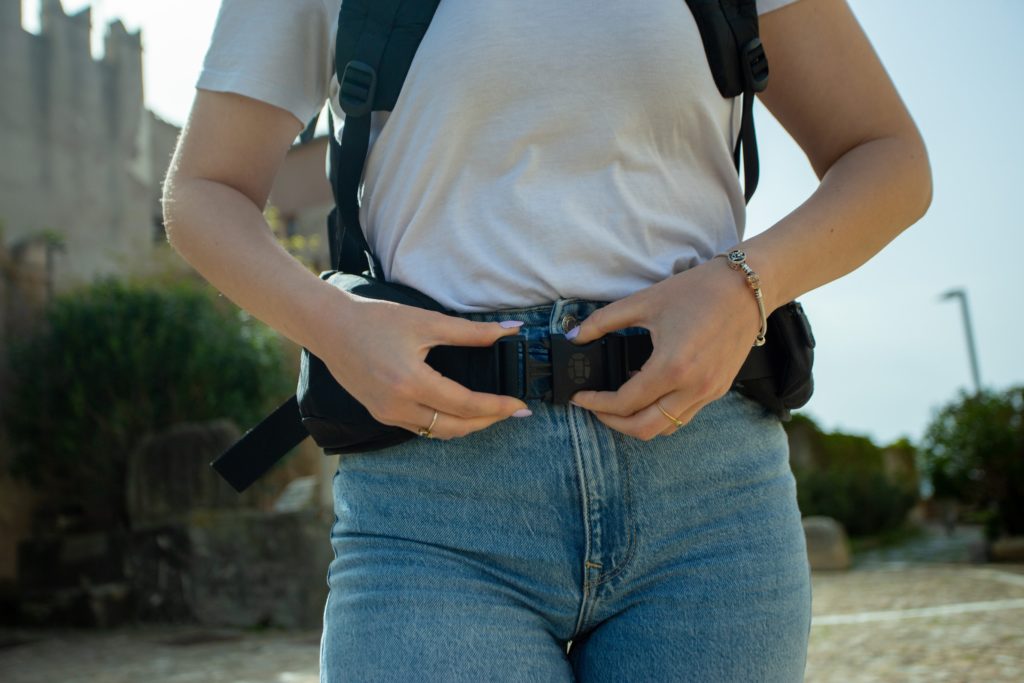
Hip Belt
The hip belt is just as, if not more, important to your comfort as the shoulder straps are. When you leave your hip belt unbuckled, you’re making your bag feel heavier and less comfortable. You might think it looks uncool, but the hip belt has a crucial job to do.
A padded, weight-bearing hip belt transfers 80% of your pack’s weight from your shoulders to your hips. That transfer allows your stronger leg muscles, not your weaker shoulders, to do the carrying.
Getting the right fit, including the hip belt, is important for a comfortable carry. If you fit and adjust your bag but don’t feel a magic moment when the weight shifts from your shoulders to your hips, you either have the wrong bag or the wrong fit. You must feel that shift to know that you have the right bag for you.
Many people wrongly assume that a hip belt’s job is to keep the bag against your body and prevent it from bouncing around. Not so. A good hip belt is weight-bearing. Make sure yours has padding. If the belt is just a strap made of webbing, it won’t transfer any weight, will squeeze into your body, and is mostly useless. Don’t buy that belt or bag.
Finally, the hip belt is an essential part of a
Torso Length
A small backpack without a hip belt can basically fit anybody. But a large backpack with a hip belt requires that you get the right fit.
Most people assume that the right size bag for them is based on their height, but a great fit is more nuanced than that. To get the right fit, you need a bag that’s sized to your torso length, not your height.
Your bag’s hip belt should sit on your hip bones, not necessarily at your waist. The shoulder straps should rest comfortably on your shoulders with no gap. Therefore, the distance between the shoulder straps and the hip belt is what creates a good fit.
You probably don’t know your torso length, so watch the video above and follow these instructions. You’ll need a tape measurer and another person to help you.
Your torso length will probably fall around 15-20”. REI defines sizing as:
- Extra small: Up to 15”+
- Small: 16-17”+
- Medium/Regular: 18-19”+
- Large/Tall: 20”+
To get a great fit, look for brands that sell multiple sizes, gender-specific fits, or adjustable fits.
We chose the latter option for our Travel Backpack. You can adjust the shoulder straps up or down to match your torso length for a perfect fit. You can even loan your bag to a friend or family member who can then adjust it to their own size.
Offering this flexibility in sizing means that the shoulder straps on the Tortuga
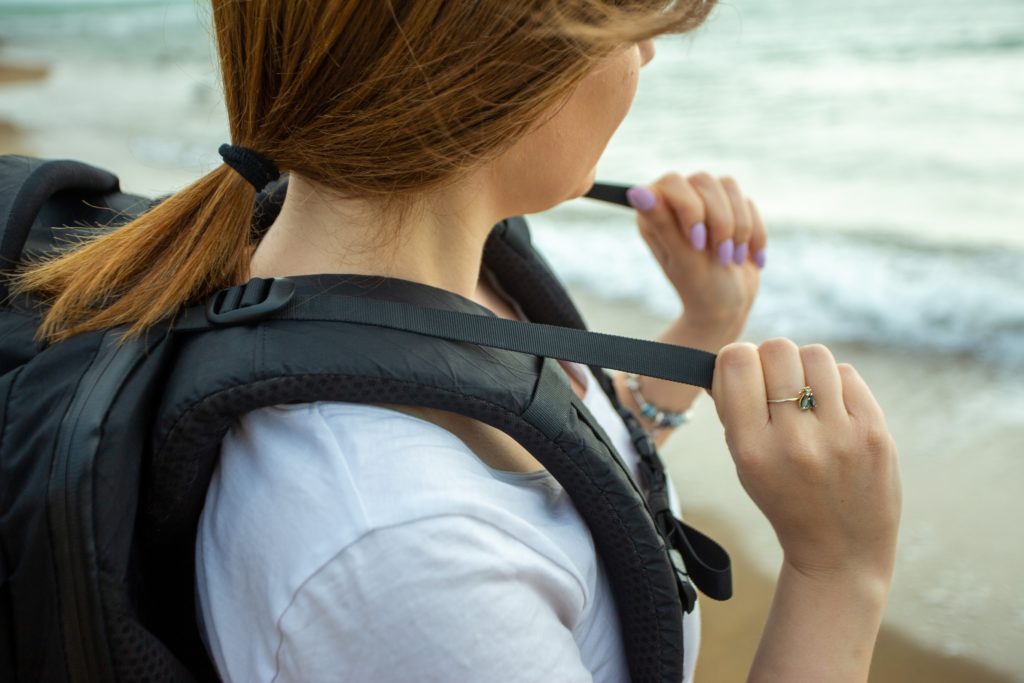
Load Lifters
If the body of your bag is higher than the shoulder straps, i.e. if the shoulder straps are not sewn into the top seam of the bag, then your bag should have load lifters. Load lifters are the webbing straps that run along your shoulder straps and connect the top of the straps to the body of the backpack. You can pull them tight to pull your bag closer to your body for a more comfortable carry.
The closer your pack’s weight is to your body, the more comfortable it will be to carry. For example, a laptop should always be packed next to your body to better manage the center of gravity. If you packed your laptop on the outside of your bag, the weight would pull on you more.
Sternum Strap
Finally, your bag should have a sternum, or chest, strap. The sternum strap connects the shoulder straps to keep the shoulder straps in, not pulling back on your shoulders, and to keep your load balanced. A sternum strap should also have a small piece of elastic to allow for some stretch while breathing and moving.
Getting the Perfect Fit
Even if a bag checks every box above, it might just not fit you well. Every bag and body is different.
So make sure to test out your bag before taking it on a trip. Fill it with weight, preferably the same stuff that you’ll pack for your trip. Then adjust all of the straps and wear the bag around for a while. Take it for a walk.
Watch the video above for how to fit and adjust a travel backpack.
Durability
The final category that we’ll cover should be an obvious one: durability. Your bag must be able to handle life on the road.
Your bag cannot fail when you’re halfway around the world. Getting it repaired or replaced will be nearly impossible. And you’ll resent your bag (and the company that made it) every day of your trip until you get home.
Materials
Travel backpacks are made of either nylon or polyester. Preconceptions that nylon is stronger and polyester is cheaper aren’t true. Both fabrics have pros and cons. There are tradeoffs to each. We outlined the differences in an article on polyester vs nylon.
More technical brands will use more advanced materials like sailcloth (e.g. X-Pac) or ultra-high molecular-weight polyethylene (e.g. Dyneema) to maximize durability without adding weight.
We’ve sampled or sold products using all of the above materials. There is no “right” answer, only choices and tradeoffs between looks, weight, price, waterproofness, abrasion resistance, and tear strength. Make sure that your
Remember that a seam—where two pieces of fabric are sewn together by a person with a sewing machine—is more likely to rip than the fabric itself. The workmanship of the bag can be even more important than the materials.
Hardware
Materials are important, but hardware is the most common failure point on a bag. A broken zipper is more common than torn fabric.
YKK zippers are the industry standard. You may have noticed the small text “YKK” on the zipper of your pants or jackets. That’s a brand name. YKK makes the world’s best zippers.
Aside from zippers, your bag will also have buckles and fasteners. There is no one “best” brand in this category, but we like Woojin, Duraflex, and A+.
Waterproofness
Related to durability is waterproofness. Do you need waterproof materials? Or a fully waterproof
Most of the time, you won’t be caught in the rain for an extended period with your luggage. You might run through a drizzle for a minute but won’t be standing around in a monsoon for hours. Yet, in the event of a downpour, you don’t want your bag getting flooded and your computer being ruined. Plan accordingly.
You don’t need a fully waterproof backpack. “Waterproof” technically means that the bag can be submerged underwater without getting anything inside wet. That’s a useful test for a dry bag meant to be taken on a boat but probably isn’t the problem that you need to solve with a
Because of the materials and construction processes required, a waterproof backpack is usually an otherwise bad
Instead, look for a water-resistant bag. Water-resistance will fall somewhere along a spectrum depending on the materials and zippers used and if you have a rain cover.
Rain Cover
The simplest and cheapest solution is a rain cover which is like a shower cap for your bag. In this case, the materials of your bag don’t matter. You just need a rain cover made of waterproof (or water-resistant) fabrics. Some covers are seam-sealed meaning that water can’t leak through the seams of the fabric. Remember that any sewn product is stitched and perforated with tiny holes along the seams which can allow water through. Sealing those seams will prevent leakage.
Rain covers are cheap and work well. However, you’ll have to remember to carry one (if it isn’t included as part of your bag) and then to put it on and take it off as needed. When you’re using the cover, you won’t be able to open or otherwise use your bag.
Water-Resistant Materials and Zippers
Next are the materials. A waterproof material means that water can’t get through the material. Water could still leak through the seams or zippers. In that case, the material, not the bag, is waterproof.
Water-resistant materials are similar but not as foolproof. Both options will often also have a durable, water-repellent (DWR) coating to make them more resistant to water seeping into the bag.
Laminated fabrics like X-Pac achieve waterproofness with a thin (0.25 mm) layer of polyester film that is waterproof. This fabric is a good way to achieve waterproofness without adding much weight or relying on DWR coatings which wear off eventually.
Finally, consider how much water might get through the zippers. Coil zippers can allow water to leak through regardless of what material your backpack is made out of. A leaky zipper, especially one on the top of your bag, can lead to a ruined computer.
Being fully waterproof is unnecessary here too. A fully waterproof zipper is extremely expensive and harder to use. You can’t easily zip and unzip them because they’re meant to stay in place. Instead, a PU-coated zipper or one with a DWR coating will provide the water resistance that you need while still being easy to use.

Additional Features
Electronics
Before buying a bag, make sure that it can safely and securely carry your electronics. Your tech may differ by trip but should account for some combination of laptop, tablet, Kindle, and phone, plus space for chargers and other peripherals.
Anything heavy, including a laptop or tablet, should be packed as close to your body as possible for better balance and weight management. Even today, some backpacks have the laptop sleeve away from the body, which is less comfortable and less balanced. Your backpack’s center of mass should be next to your body.
Your bag’s laptop sleeve should be padded for protection and also have a “false bottom.” A false bottom means that the horizontal seam that forms the bottom of the laptop sleeve is above the (vertical) bottom of your bag. The computer should be suspended above the bottom of the bag when you put it down. The larger that gap, the better. A false bottom prevents the bottom edge of your computer from hitting the ground when you put your bag down.
Everything said about a laptop also applies to a tablet.
If you’re a reader, make sure your bag has a flat pocket for your Kindle somewhere within easy reach when you’re on the plane.
For added security, you can also consider a locking compartment for your computer.
Security
How secure your bag needs to be is subjective. Some travelers carry a money belt, lock every pocket on their bag, and chain the whole thing in place. Others take a “live and let live” approach. I’ll admit to being in the latter camp. I put my wallet in my front pocket, keep an eye on my bag, and am content with this level of “risk.”
Backpack security starts with locking zippers (which come in many variations) but can also include slash-proof fabric, puncture-proof zippers, RFID blocking, and even a literal cage to secure your bag.
As a company, we don’t want to try to scare you in order to sell security products. We believe that’s dishonest and misleading. Risk exists when traveling, just like it does at home, but you shouldn’t let it drive your packing or travel decisions.
You don’t need a dedicated anti-theft backpack. Instead, your goal is to not be the easiest mark. Thieves are looking for an easy score, not a high degree of difficulty.
First, use common sense. The more “touristy” an area, the more likely it is to attract pickpockets and thieves. Leave your bag at your accommodations and lock the door there.
Next, choose a low-profile bag. The larger and more colorful your bag, the more you’ll stand out. Pack a small bag in a muted color. Blend in. The ideal
These two simple choices will give you most of the protection you need. Locking zippers can be a sensible addition if only for the message that it sends to potential thieves: this bag is locked. Beyond that, many security features are unnecessary and only add to the cost and weight of your gear with little practical benefit.
Pack for trips of one week or more without checking a bag.
- Thick comfortable straps
- Easy to organize
- Durable, waterproof fabric
- Backed by our Worldwide Warranty
What About These Travel Backpacks?
Travel Backpacks for Women
Like everyone else, women must get the right fit in their travel backpack for a comfortable carry. Everyone’s packing needs differ, but most bags are flexible enough to accommodate most travelers and packing styles.
Depending on your frame and body type, your ideal bag may be a gender-neutral fit (most bags), a
Travel Backpacks with Wheels
A backpack with wheels, or a suitcase with backpack straps, is the worst form of backpack/suitcase combo.
As a suitcase, it’s fine but still has shortcomings. As a backpack, it’s a disaster.
The plastic handle and wheel assembly add significant weight that you’ll have to carry around whenever you aren’t rolling your bag. Most of these hybrids have flimsy shoulder straps and no hip belt, so you’re carrying extra weight on your shoulders, not your hips as covered earlier.
The handle and wheels will also use 20% or more of your
Expandable Travel Backpacks
Expandable backpacks are a popular option for travelers who want the flexibility of a single bag that can shrink down for short trips or expand for long trips. We’ve made, and I’ve carried, expandable bags in the past.
The benefits of sizing flexibility are obvious, so let’s consider the downside. Remember that an expandable bag isn’t magic. An expandable bag is the larger size (that it expands to) plus some extra hardware. You’re always carrying that larger bag’s amount of fabric and adding more hardware (zippers, buttons, or magnets) to cinch down its size. Expandable bags are really cinch-able bags. They’re a full-sized pack with extra hardware. When shrunk, they still have that extra hardware and fabric.
This shouldn’t be a deal-breaker but is worth considering when comparing two similarly-sized packs.
One Bag That Does Everything
There has been a trend in technical clothing—especially on Kickstarter—that now affects bags: the one product with tons of features that does everything and works for every situation.
For clothes, it’s the pants that can be worn to the office, for a night out, for hiking, for traveling, and for every other situation in your life. For bags, it’s the bag for work, school, travel, the outdoors, the gym, and everything else.
Of course, a bag is a bag and can work for many situations. If you don’t travel much, you shouldn’t invest in a dedicated, technical
A product that does everything does nothing well.
I know. I’ve built some Frankenstein products in the past where I tried to fit every idea into one bag. Like with packing, it won’t all fit.
Product design is about making hard decisions and accepting tradeoffs. I’ve learned my lesson. As a product designer, I now try to build gear with a few core benefits for a specific type of person or trip. Every other decision about that product should support those core benefits.
As a consumer, beware of the one product that will be great at everything. Buying one bag that’s mediocre at everything is totally possible. But if you want a great tool, you’ll need a specific one for the job.
Conclusion
Now you’re the expert on travel backpacks. You’ve learned everything that I’ve learned in twelve years of making bags. I hope you feel confident in finding the perfect bag for you and your next trip.
As a final recap, remember to look for a



